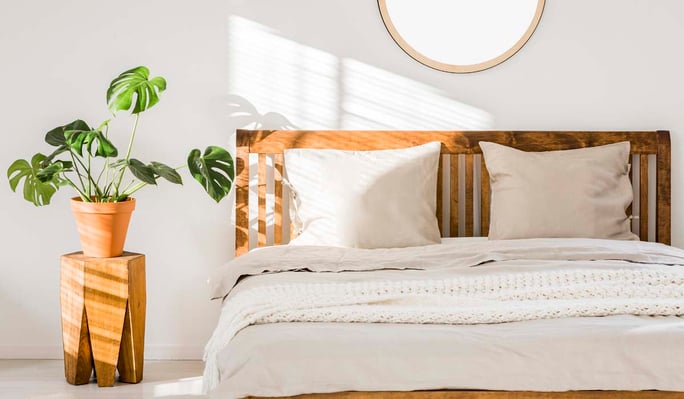A Beginner's Guide To Indoor Plants

Contents

Indoor plants can be intimidating for any new plant parent, but it doesn't have to feel that way. We've put together this beginner’s guide of 4 plants that thrive inside so you can gain confidence and be successful.

1. Pothos
Pothos are beautiful, trailing plants that can tolerate low light conditions and look glamorous sitting on a flat surface in a planter or in a hanging basket. They also come in a wide variety of variations like Marble Pothos, Golden Pothos, Neon Pothos, and so many more. They are an affordable house plant and considered by many to be a wonderful way to get started with houseplants. Pothos can be easily propagated so you can make more plants.
How to care for pothos:
The best thing about pothos is that they do well in a wide range of environments. They do well in bright, indirect light, and low light and can be grown in dry soil or in vases of water. Pothos thrive in nutrient-rich soil but often do as well in nutrient-poor soil.
When looking for the best soil for your pothos, look for any ordinary, well-draining potting soil. Pothos like to have its soil dry completely out between waterings. The plant will indicate when it needs water by starting to droop. Check your pothos plant once per week, and if the soil is dry to the touch, give the plant a nice healthy drink of water.
Pothos will let you know if it has been over watered by showing black spots on leaves or the collapse of the plant. This indicates that the soil has been kept too wet. On the other hand, if the plant has been dry for too long, it will begin to show dry, brown edges.
Pothos are not heavy feeders but can benefit from a monthly to bi-monthly fertilizer to increase nutrition. Any balanced houseplant fertilizer will do.

2. Monstera
Grand and flamboyant, the monstera plant is a wonderful indoor plant that can grow in many ways depending on the variety. Monstera is a popular houseplant because of its chic, eye-catching look and its easy-to-grow characteristics. Some trail and have Swiss cheese-styled leaves, while others grow tall and have multi-colored leaves that are as big as your head! The easiest and most popular version would be the Monstera Deliciosa, which does well in low light situations and doesn't need constant attention.
How to care for monstera:
As a houseplant, monsteras do best in a deep pot with many drainage holes. They prefer bright, indirect sunlight in temperatures between 65F-75F. It is best to avoid too much direct light, as it may burn the foliage.
Monstera will do best in a peat-based potting media and thrives in well-drained, moderately moist soil. Give the plant regular waterings every one to two weeks during the spring and summer months which is the active growing season. Water until excess water drains through the drainage holes. The soil needs to dry out slightly between waterings. During the fall and winter months, water only occasionally. To increase humidity indoors, you can mist the foliage using a spray bottle of demineralized water.
Monstera can be fertilized with a balanced liquid houseplant fertilizer every few weeks during the growing season.

3. Snake Plant
The snake plant, or more specifically Dracaena Trifasciata, is a beautifully marked and lanky plant that grows like a succulent. With sturdy leaves and the ability to grow in almost any condition, it's become a popular house plant. This plant also has the common name of “mother-in-law’s tongue.” Snake plants are an ideal choice for beginner gardeners because they are difficult to kill.
How to care for snake plants:
Snake plants will thrive in very bright light or even the darkest corners of your house. They prefer indirect, steady light with some direct sun.
Snake plants are considered drought-resistant but can be susceptible to over-watering and root rot. In the winter months, you only need to water monthly or whenever the soil is dry to the touch. In warmer months, water them every three to four weeks. Err on the side of under-watering since too much water can harm the plant.
These plants prefer loose, well-drained potting mix. Be sure to use a potting mix medium to low in peat content, because sometimes peat can become tightly packed and have problems rehydrating. Any all-purpose cactus potting soil would work great.
Snake plants only need mild cactus fertilizer during the growing season. No need to fertilize in the winter.

4. ZZ Plant
Not to be confused with the band ZZ Top, this interesting plant has grown a respectable following on social media for its wide, alluring, verdant leaves and the chic, modern appearance it gives to any room. The zz plant (aka the Zanzibar Gem) will live through low light, drought, and even neglect. They can grow as tall as three feet very quickly, so be ready for a beautiful plant that you do not have to babysit. The zz plant a great low-maintenance houseplant for the new plant parent.
How to care for zz plants:
ZZ plants can survive without any natural light, but they do their best in bright, indirect light. Avoid direct sunlight so as not to burn the leaves of the plant.
ZZ plants do great in a standard well-draining potting mix. They are extremely drought-tolerant and can handle infrequent waterings. They should be watered once the soil dries out completely, usually once every week, depending on the growing conditions. When watering, give it enough water so that the moisture runs out of the bottom of the pot and then discard the excess water.
ZZ plants do not require regular fertilizing to thrive, but feeding can help the plant’s overall health. Fertilize your plant with indoor plant fertilizer diluted to half strength one or two times during its active growing season.
Indoor plants can be intimidating, but they do not have to be complicated. By reading this guide and researching additional facts about the specific plant you might want to purchase, you can grow your plant family with success.
Which one of these plants are you going to bring home next? Let us know on Instagram @incolorplants.
Good luck, plant friends!
Gardening Question?
Ask Our Experts and we'll get back to you!
